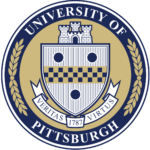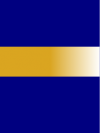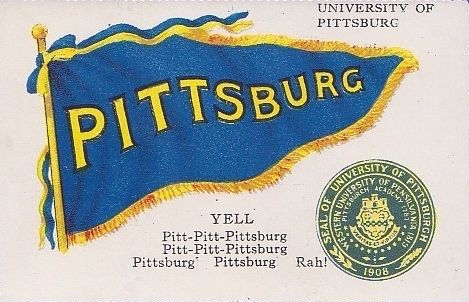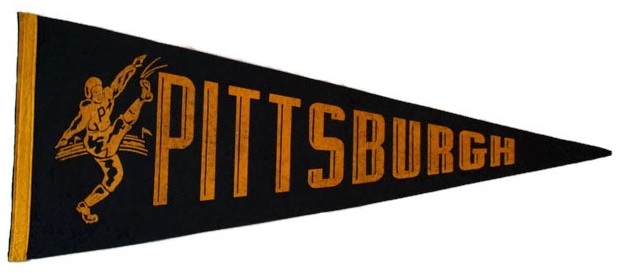University of Pittsburgh
Pennsylvania
1787
Formerly “Western University of Pennsylvania”






Western University of Pennsylvania adopted school colors of navy blue and old gold in 1889. In collegiate souvenirs from that period, the university’s old gold color was often depicted as orange.
Citations in the World Almanac (listed by cover date; color information is from the previous year): old gold/navy blue (1897-1906); gold/blue (1908); blue/gold (1909-1914); old gold/blue (1915-1916); blue/gold (1918-1935)
Before the 1895 Intercollegiate Code of Academic Costume was ratified, Western University of Pennsylvania had been an early client of Cotrell & Leonard, the academic costume manufacturer for most of the prestigious east coast colleges and universities in the US at the end of the 19th century. As a client of Cotrell & Leonard, Western was one of the schools in a list of college colors compiled by the 1894-95 Intercollegiate Commission to accompany the text of the 1895 Intercollegiate Code using information from the 1894 World Almanac and from the client records of Cotrell & Leonard. Western’s school colors in this list – old gold and blue – would have been understood to be the colors in Western’s hood lining.
The university was stated to be a client of Cotrell & Leonard in an advertisement in the December 1895 issue of the Yale Literary Magazine, so perhaps the Intercollegiate Bureau of Academic Costume (IBAC) — which was affiliated with Cotrell & Leonard — had assigned a hood lining to Western by that point. In any case, the IBAC had certainly assigned a hood to the university by 1898, when Cotrell & Leonard created a Western University of Pennsylvania Doctor of Laws hood for Spanish-American War hero Admiral George Dewey, according to the 23 October 1898 edition of The Argus, an Albany, NY newspaper.
None of these early citations described how the Intercollegiate Bureau had arranged the old gold and navy blue colors of the university in the hood lining, but apparently the IBAC had assigned Western University of Pennsylvania a navy blue lining with an orange chevron. The first definitive description of Western’s hood lining is in an IBAC list from c.1912 where the university is listed twice: once as “Western University of Pennsylvania” and once as the “University of Pittsburgh” (the new name of the school since 1908). The Intercollegiate Bureau’s hood lining pattern for the old Western University of Pennsylvania was described as national blue (dark blue) with an orange chevron. At the turn of the century “orange” was often a synonym for “old gold” and both colors were used for souvenirs and other printed materials for the university, so the Bureau probably used orange to avoid duplicating the navy blue and old gold hood lining already assigned to Allegheny College.
The IBAC described the lining for the hood of the new University of Pittsburgh as blue with a gold chevron. By 1918 the IBAC had revised its description of the colors for Pittsburgh and said that Pittsburgh’s hood had a navy blue lining with a gold yellow (light orange) chevron. The Bureau changed gold yellow to gold by the middle of the 1920s, but otherwise Pittsburgh’s hood lining pattern remained the same.
Unfortunately, this was essentially the same description of the hood lining the IBAC had also assigned to Simmons College and Goucher College by 1918.
As the number of IBAC-registered schools increased during the early 1900s, and as the number of IBAC-registered schools with the same college colors increased, the Bureau found it increasingly difficult to avoid duplicating the hoods they assigned to these colleges and universities that used the same colors. To solve this problem, the IBAC used distinctive heraldic divisions for some schools, but unfortunately also began to employ semantic slights-of-hand to disguise the fact that schools were being assigned hoods that were, practically speaking, identical. For instance, in the 1918 Intercollegiate Bureau list discussed above there were no less than three schools that had been assigned identical dark blue and gold hood linings by the IBAC: Goucher College (dark blue with a gold yellow chevron), the University of Pittsburgh (navy blue with a gold yellow chevron), and Simmons College (dark blue with a gold chevron). Although each IBAC description was differently-worded, each hood was essentially the same design: a dark blue lining with a gold chevron.
These duplications have been avoided here by using the original Intercollegiate Bureau hood assignment for each school, and if necessary, assigning a new and unique heraldic division of the colors in each school’s hood lining. There is historical precedent for this because double chevrons, triple chevrons, colors divided parti-per chevron, and horizontal bars (what the IBAC called “zones”) were already being used by the Bureau in the late 1890s and early 1900s, but it is not known today why the IBAC did not use these and other heraldic divisions more often.

So to avoid duplicating the identical IBAC hood patterns assigned to Goucher College and Simmons College, the earliest (c.1895-1897) IBAC assignment for Western University of Pennsylvania has been retained (navy blue with an orange chevron), but with the orange corrected to old gold. To avoid duplication with the hood lining the IBAC assigned to the Allegheny College (navy blue with an old gold chevron), the University of Pittsburgh has been reassigned a horizontal bar in old gold, echoing the heraldic bar found in the old seal of the Western University of Pennsylvania (which incorporated the coat of arms of the state of Pennsylvania) and the current seal of the University of Pittsburgh.